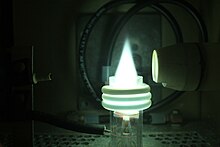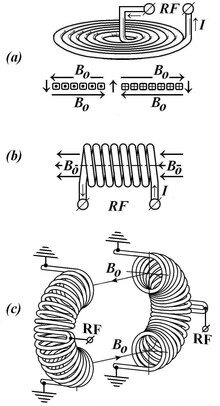84:
20:
72:
347:
suggests that the gas ion motion is most intense in the outer region of the flame, where the temperature is the greatest. In the real torch, the flame is cooled by the cooling gas from the outside , so the hottest outer part is at thermal equilibrium. Temperature there reaches 5 000 – 6 000 K. For
75:
Fig. 2. The construction of
Inductively Coupled Plasma torch. A: cooling gas tangential flow to the outer quartz tube B: discharge gas flow (usually Ar) C: flow of carrier gas with sample D: induction coil which forms the strong magnetic field inside the torch E: force vectors of the magnetic
359:
which contains the coil is usually 27–41 MHz. To induce plasma, a spark is produced at the electrodes at the gas outlet. Argon is one example of a commonly used rarefied gas. The high temperature of the plasma allows the atomization of molecules and thus determination of many elements, and in
379:
can range between ~6,000 K and ~10,000 K and are usually several orders of magnitude greater than the temperature of the neutral species. Temperatures of argon ICP plasma discharge are typically ~5,500 to 6,500 K and are therefore comparable to those reached at the surface
338:
384:) of the sun (~4,500 K to ~6,000 K). ICP discharges are of relatively high electron density, on the order of 10 cm. As a result, ICP discharges have wide applications wherever a high-density plasma (HDP) is needed.
360:
addition, for about 60 elements the degree of ionization in the torch exceeds 90%. The ICP torch consumes c. 1250–1550 W of power, and this depends on the element composition of the sample (due to different
179:
367:
The ICPs have two operation modes, called capacitive (E) mode with low plasma density and inductive (H) mode with high plasma density. Transition from E to H heating mode occurs with external inputs.
397:
252:
558:
Shun'ko, Evgeny V.; Stevenson, David E.; Belkin, Veniamin S. (2014). "Inductively
Coupling Plasma Reactor With Plasma Electron Energy Controllable in the Range From ~6 to ~100 eV".
609:Бабушкин, А. А.; Бажулин, П. А.; Королёв, Ф. А.; Левшин, Л. В.; Прокофьев, В. К.; Стриганов, А. Р. (1962). "Эмиссионный спектральный анализ". In Гольденберг, Г. С. (ed.).
428:
Another benefit of ICP discharges is that they are relatively free of contamination, because the electrodes are completely outside the reaction chamber. By contrast, in a
407:
685:
471:
High density fluorocarbon etching of silicon in an inductively coupled plasma: Mechanism of etching through a thick steady state fluorocarbon layer
262:
432:(CCP), the electrodes are often placed inside the reactor chamber and are thus exposed to the plasma and to subsequent reactive chemical species.
388:
514:
539:
361:
107:
91:
In planar geometry, the electrode is a length of flat metal wound like a spiral (or coil). In cylindrical geometry, it is like a
102:
When a time-varying electric current is passed through the coil, it creates a time-varying magnetic field around it, with flux
473:
192:
349:
80:
There are three types of ICP geometries: planar (Fig. 3 (a)), cylindrical (Fig. 3 (b)), and half-toroidal (Fig. 3 (c)).
401:
392:
651:
Hyo-Chang Lee (2018) Review of inductively coupled plasmas: Nano-applications and bistable hysteresis physics 5 011108
446:
441:
429:
451:
56:
670:
211:
675:
343:
leading to the formation of the electron trajectories providing a plasma generation. The dependence on
567:
421:
417:
376:
630:
Flame Atomic
Absorbance and Emission Spectrometry and Inductively Coupled Plasma — Mass Spectrometry
680:
199:
591:
583:
535:
510:
411:
96:
575:
52:
44:
19:
628:
477:
83:
571:
480:
T. E. F. M. Standaert, M. Schaepkens, N. R. Rueger, P. G. M. Sebel, and G. S. Oehrleinc
60:
664:
595:
470:
381:
356:
203:
587:
579:
333:{\displaystyle E={\frac {U}{2\pi r}}={\frac {\omega rH_{0}}{2}}\sin \omega t}
196:
71:
48:
652:
92:
82:
70:
18:
188:
is the distance to the center of coil (and of the quartz tube).
492:
Inductively
Coupled Plasmas in Analytical Atomic Spectrometry
174:{\displaystyle \Phi =\pi r^{2}H=\pi r^{2}H_{0}\cos \omega t}
534:. Cambridge University Press, Cambridge. pp. 219–259.
507:
Spectrochemical
Analysis by Atomic Absorption and Emission
509:(2 ed.). Cambridge: RSC Publishing. p. 205.
553:
551:
265:
214:
110:
332:
246:
173:
530:Pascal Chambert and Nicholas Braithwaite (2011).
355:The frequency of alternating current used in the
257:which corresponds to electric field strengths of
99:cut along its main diameter to two equal halves.
490:A. Montaser and D. W. Golightly, ed. (1992).
8:
622:
620:
95:spring. In half-toroidal geometry, it is a
76:field F: the plasma torch (the discharge).
627:Dunnivant, F. M.; Ginsbach, J. W. (2017).
23:Fig. 1. Picture of an analytical ICP torch
306:
293:
272:
264:
224:
213:
153:
143:
124:
109:
505:Lajunen, L. H. J.; Perämäki, P. (2004).
613:. Москва: Издательство МГУ. p. 58.
463:
247:{\displaystyle U=-{\frac {d\Phi }{dt}}}
87:Fig. 3. Conventional Plasma Inductors
7:
560:IEEE Transactions on Plasma Science
686:Plasma technology and applications
532:Physics of Radio-Frequency Plasmas
230:
111:
14:
653:https://doi.org/10.1063/1.5012001
494:. VCH Publishers, Inc., New York.
348:more rigorous description, see
193:Faraday–Lenz's law of induction
1:
611:Методы спектрального анализа
402:atomic emission spectroscopy
393:atomic emission spectroscopy
447:Induction plasma technology
442:Capacitively coupled plasma
430:capacitively coupled plasma
352:in electromagnetic fields.
59:, that is, by time-varying
702:
37:transformer coupled plasma
29:inductively coupled plasma
452:Pulsed inductive thruster
57:electromagnetic induction
580:10.1109/TPS.2014.2299954
350:Hamilton–Jacobi equation
334:
248:
175:
88:
77:
55:which are produced by
24:
377:electron temperatures
335:
249:
176:
86:
74:
22:
16:Type of plasma source
422:reactive-ion etching
263:
212:
108:
47:source in which the
572:2014ITPS...42..774S
362:ionization energies
200:electromotive force
476:2016-02-07 at the
330:
244:
171:
89:
78:
25:
633:. Whitman College
516:978-0-85404-624-9
412:mass spectrometry
316:
288:
242:
191:According to the
97:toroidal solenoid
53:electric currents
693:
655:
649:
643:
642:
640:
638:
624:
615:
614:
606:
600:
599:
555:
546:
545:
541:978-0521-76300-4
527:
521:
520:
502:
496:
495:
487:
481:
468:
339:
337:
336:
331:
317:
312:
311:
310:
294:
289:
287:
273:
253:
251:
250:
245:
243:
241:
233:
225:
180:
178:
177:
172:
158:
157:
148:
147:
129:
128:
701:
700:
696:
695:
694:
692:
691:
690:
671:Electrodynamics
661:
660:
659:
658:
650:
646:
636:
634:
626:
625:
618:
608:
607:
603:
557:
556:
549:
542:
529:
528:
524:
517:
504:
503:
499:
489:
488:
484:
478:Wayback Machine
469:
465:
460:
438:
373:
302:
295:
277:
261:
260:
234:
226:
210:
209:
195:, this creates
149:
139:
120:
106:
105:
69:
61:magnetic fields
51:is supplied by
43:) is a type of
17:
12:
11:
5:
699:
697:
689:
688:
683:
678:
673:
663:
662:
657:
656:
644:
616:
601:
566:(3): 774–785.
547:
540:
522:
515:
497:
482:
462:
461:
459:
456:
455:
454:
449:
444:
437:
434:
426:
425:
415:
405:
395:
372:
369:
329:
326:
323:
320:
315:
309:
305:
301:
298:
292:
286:
283:
280:
276:
271:
268:
240:
237:
232:
229:
223:
220:
217:
170:
167:
164:
161:
156:
152:
146:
142:
138:
135:
132:
127:
123:
119:
116:
113:
68:
65:
15:
13:
10:
9:
6:
4:
3:
2:
698:
687:
684:
682:
679:
677:
674:
672:
669:
668:
666:
654:
648:
645:
632:
631:
623:
621:
617:
612:
605:
602:
597:
593:
589:
585:
581:
577:
573:
569:
565:
561:
554:
552:
548:
543:
537:
533:
526:
523:
518:
512:
508:
501:
498:
493:
486:
483:
479:
475:
472:
467:
464:
457:
453:
450:
448:
445:
443:
440:
439:
435:
433:
431:
423:
419:
416:
413:
409:
406:
403:
399:
396:
394:
390:
387:
386:
385:
383:
378:
370:
368:
365:
363:
358:
353:
351:
346:
341:
327:
324:
321:
318:
313:
307:
303:
299:
296:
290:
284:
281:
278:
274:
269:
266:
258:
255:
238:
235:
227:
221:
218:
215:
207:
205:
201:
198:
194:
189:
187:
182:
168:
165:
162:
159:
154:
150:
144:
140:
136:
133:
130:
125:
121:
117:
114:
103:
100:
98:
94:
85:
81:
73:
66:
64:
62:
58:
54:
50:
46:
42:
38:
34:
30:
21:
676:Spectroscopy
647:
635:. Retrieved
629:
610:
604:
563:
559:
531:
525:
506:
500:
491:
485:
466:
427:
420:, a type of
410:, a type of
400:, a type of
391:, a type of
374:
371:Applications
366:
354:
344:
342:
259:
256:
208:
190:
185:
183:
104:
101:
90:
79:
40:
36:
32:
28:
26:
382:photosphere
357:RLC circuit
681:Ion source
665:Categories
637:10 January
458:References
588:0093-3813
325:ω
322:
297:ω
282:π
231:Φ
222:−
197:azimuthal
166:ω
163:
137:π
118:π
112:Φ
67:Operation
596:34765246
474:Archived
436:See also
204:rarefied
568:Bibcode
418:ICP-RIE
398:ICP-AES
389:ICP-OES
375:Plasma
202:in the
93:helical
594:
586:
538:
513:
408:ICP-MS
184:where
49:energy
45:plasma
592:S2CID
206:gas:
35:) or
639:2018
584:ISSN
536:ISBN
511:ISBN
576:doi
364:).
319:sin
160:cos
41:TCP
33:ICP
27:An
667::
619:^
590:.
582:.
574:.
564:42
562:.
550:^
340:,
254:,
181:,
63:.
641:.
598:.
578::
570::
544:.
519:.
424:.
414:.
404:.
380:(
345:r
328:t
314:2
308:0
304:H
300:r
291:=
285:r
279:2
275:U
270:=
267:E
239:t
236:d
228:d
219:=
216:U
186:r
169:t
155:0
151:H
145:2
141:r
134:=
131:H
126:2
122:r
115:=
39:(
31:(
Text is available under the Creative Commons Attribution-ShareAlike License. Additional terms may apply.


